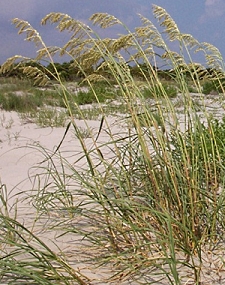Wildlife - Species

Sea Oats (Uniola paniculata)
Description
Sea oats, a salt-loving species, belongs to the grass family (Poaceae). The plant produces a well- developed rhizome (horizontal root) system, and 0.5-1.5 m (1.6-5 ft) tall culms (stems) sprout from the node along the rhizomes. The leaves are lance-shaped and are up to 20 cm (8 in) tall and 0.2-2.5 cm (less than 1 in) wide. Both surfaces of the leaves are free of hairs, with only a few at the leaf base, and the margins are scaberulous, long, and up to 2 cm (0.8 in) wide. The panicles (flowering stems) are 20-50 cm (8-20 in) long and 5-15 cm (2-6 in) wide, free of hair and ascending.
Preferred Habitat and Biology
Sea oats are found from Virginia to the Florida Panhandle and west to Mississippi. The plants inhabit sandy dunes on coastal islands and along the coastlines. In South Carolina, the plant grows on the dunes along the coastal mainland in Horry and Georgetown Counties, and the barrier islands that are found from Berkeley to Beaufort Counties, including Otter and Edisto Islands in the ACE Basin.
Sea oats thrive in the unstable, xeric environment of the dune community. When new sand is deposited, the plants extend their rhizomes (horizontal roots) over and through the new sands, which contain vital nutrients needed for plant growth. The newly established roots then produce shoots, and additional leaves sprout from the base of the new leaves, forming tussocks (clumps of leaves). Their extensive rhizome system helps to stabilizes the sand around the plants, and the tussock growth form acts as a wind break. The tussocks also enable the plants to trap sand near the base of the clumps. The species grows best under the low soil-moisture conditions in the dune community. In fact, frequent watering of the soil will retard plant growth and eventually kill the plants. New sea oat populations are established by sexual reproduction. Sea oats produce flowers in July, which are fertilized by wind-dispersed pollen, and by mid-August the fully developed, fertilized seeds are then dispersed by the wind to new dunes. The seeds remain dormant through the fall and winter and germinate during the spring. The percentage of seeds that sprout depends on how deep the seeds were buried under the sand. Studies have indicated that there is enough food reserve in the seed to support the first three to five inches of growth. The highest percentage of germination occurred in areas where the seeds were buried under two to four inches of sand. The root system of the seedlings develops rapidly during the first two months, and often the roots extend 10 times the height of the shoot. The extensive root system of the seedling functions like that of the adult plants: it enables the sea oats seedling to extend into and stabilize the shifting sands.
Species Significance
This species is among the most effective native sand-binding grasses. Therefore, this species is an important contributor to dune formation and stabilization. The South Carolina Department of Natural Resources, Heritage Trust Program, considers sea oats to be a species of concern. Current data indicate that their populations in the state may be declining due to habitat (i.e., wet or well-drained soils, loamy or sandy or mucky substrate) loss or alteration or pollution.
References
Oosting, H.J. and W.D. Billings. 1942. Factors effecting vegetational zonation on coastal dunes. Ecology 23(2):131-142.
Radford, A.E., H.E. Ahles, and C.R. Bell. 1968. Manual of the vascular flora of the Carolinas. The University of North Carolina Press, Chapel Hill, NC.
Wagner, R.H. 1964. The ecology of Uniola paniculata L. in the dune-strand habitat of North Carolina. Ecological Monographs 34(1):79-96.
